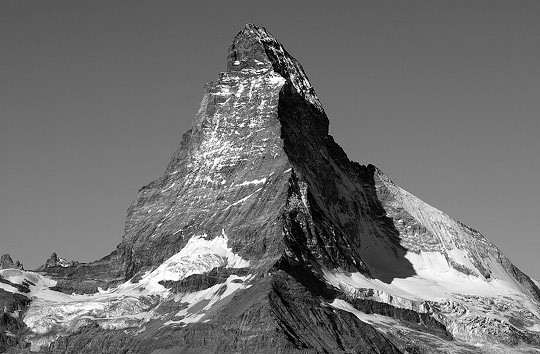
The Matterhorn (4478m), Valais Alps, viewed from the northeast. The Hornli Ridge (AD) is the striking arete that divides sun and shadow. On September 6, Simon Anthamatten and Michael Lerjen made a record retour of the ridge in 2 hours and 33 minutes. Although modest about their accomplishment, it was a record that had not been broken for fifty-four years. [Photo] Menno Boermans
On September 6, 2007, mountain guides Simon Anthamatten and Michael Lerjen, both of Zermatt, Switzerland, ascended and descended the Hornli Ridge (AD) on the Matterhorn (4478m) in a record retour (combined time of ascent and descent) of 2 hours, 33 minutes. The pair ascended from the Hornli Hut and climbed the route, established in 1865 during the first ascent of the Matterhorn, in a mere 1 hour and 40 minutes. Their descent took 53 minutes. Despite the impressive rate of Anthamatten’s and Lerjen’s ascent, the two guides do not consider their climb to be sensational or groundbreaking, but rather fun climbing on one of the most beautiful peaks in the world. It remains, however, that their achievement is outstanding relative to the seven to nine hours required by most fit climbers.
At age 23, Anthamatten, one of the youngest guides in Switzerland, boasts a well-rounded climbing resume that includes the west face of Bagirathi III (6454m) at age 20, Freerider (5.12d) on Yosemite’s El Capitan, Air Sweden (5.13R) in Indian Creek, Vertical Limit (M12) in Ueschinen, Switzerland, the Gogna-Cerruti (ED+: 5.10 A3, 1100m, Cerruti-Gogna, 1969) on the Matterhorn’s north face as well as the Japanese Direttissima (5.9 A3, 1800m, Imai-Kato-Kato-Negishi-Hirofumi-Kubo, 1969) on the north face of the Eiger. Anthamatten’s partner Lerjen, an accomplished climber in his own right, climbed Nanga Parbat in 2004 at the age of 18. He remains the youngest Swiss alpinist to summit an 8000-meter peak.
Anthamatten and Lerjen’s effort bested the previous record established in 1953 by Swiss guide Alfons Lerjen and Zermatt local Hermann Biner. Biner, only 15 years old at the time, had been working for his sister at the Hotel Belvedere, situated coincidentally at the base of the Matterhorn. Each day, Biner would take time to sit on the hotel terrace and admire the beauty of the mountain; eventually Biner desired to stand on the summit. He found leadership in Swiss mountain guide Alfons Lerjen, and in August of 1953, Lerjen and Biner prepared to climb the Hornli Ridge.
On the day of their climb, Biner, climbing in a pair of borrowed shoes and a wind jacket, began the route with Lerjen at 8 a.m. They made rapid progress up the ridge, and much to their surprise, found themselves on the summit in just under two hours. They quickly descended, and by 11 a.m. the pair stood back at the Hotel Belvedere, having achieved an amazing retour record of only three hours. The climb was well ahead of its time in both speed and style, and regardless of the line’s technical ease (5.3), such an accomplishment foreshadowed the light and fast alpine-style ethic that is lauded today.
The Hornli Ridge, which follows the Matterhorn’s prominent northeast ridgeline, was climbed first by Englishman Edward Whymper and a team of six companions in 1865. Whymper had attempted the mountain’s southeast ridge unsuccessfully from the Italian side a number of times with partner and Italian guide Jean-Antoine Carrel. While his attempts with Carrel proved fruitless, Whymper ultimately joined forces with French guide Michael Croz, Englishman Lord Francis Douglas, father-and-son guides Peter and Peter Taugwalder, Reverend Charles Hudson and Robert Hadow to tackle the mountain from the Swiss side. With plans to climb the northeast ridge, the team left Zermatt on July 13 and bivouacked below the route before ascending the ridge on July 14, reaching the top at approximately 1:40 p.m.
Despite Whymper’s success in summiting the mountain, the descent tragically claimed the lives of partners Robert Hadow, Michael Croz, Charles Hudson, and Lord Francis Douglas when Hadow slipped below the summit, falling onto Croz and subsequently pulling Hudson and Douglas off the face. All seven men were still roped together, and when the four began to fall, the elder Peter Taugwalder attempted to save his companions by belaying the rope around a rock. Despite his efforts to stop the fall, the rope snapped, and the four men fell to their death.
Approached from the Swiss side of the mountain, the Hornli Ridge has become the most popular option for climbers and non-climbers alike interested in ascending to the Matterhorn’s iconic summit. Numerous ropes have been fixed on the route, and as a result, many climbers underestimate the overall difficulty of the ridge. On good weather days, “traffic jams” clog the fixed lines, lending to mass crowding and the increased potential for accidents. The route has an impressive climbing distance of 1700 meters and a vertical gain of 1200 meters. For more history and accounts of climbing the Matterhorn, see Issue 16’s “Mountain Profile.”